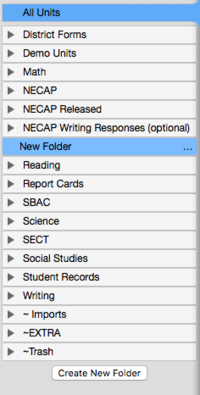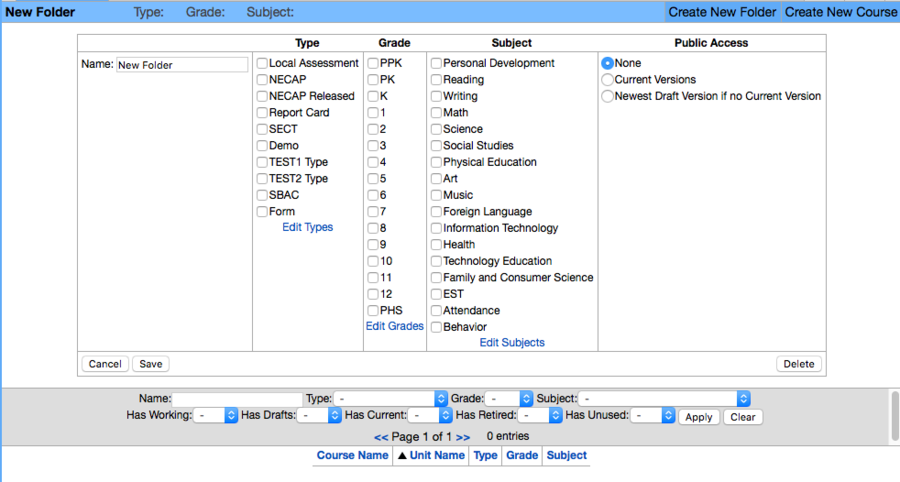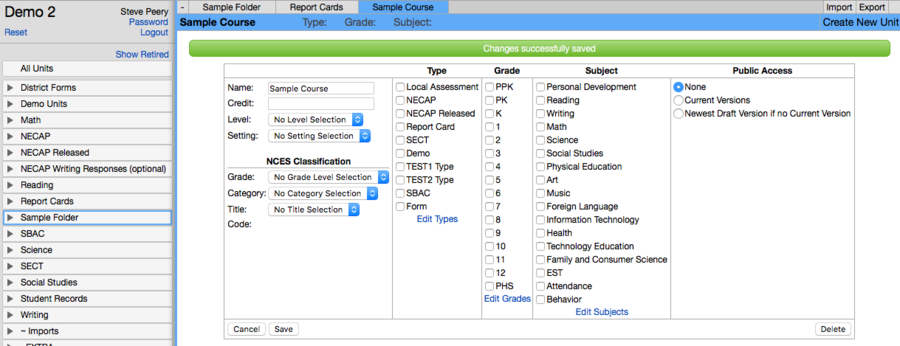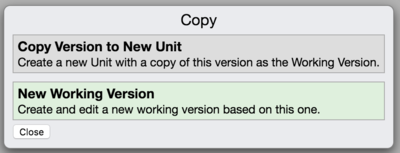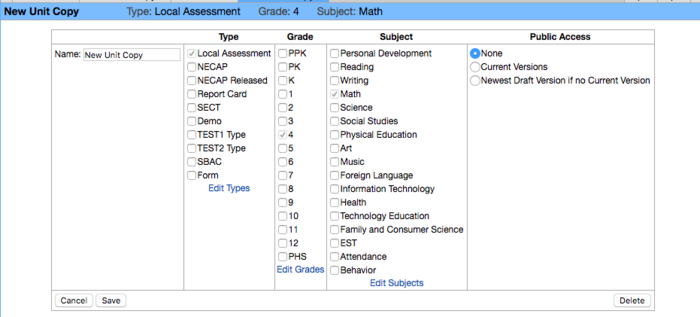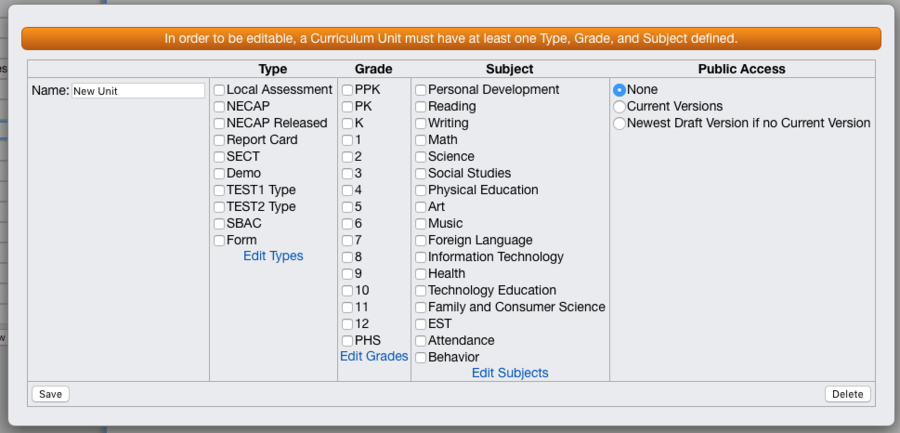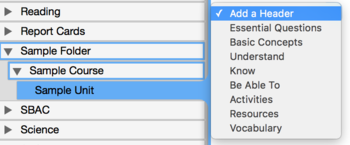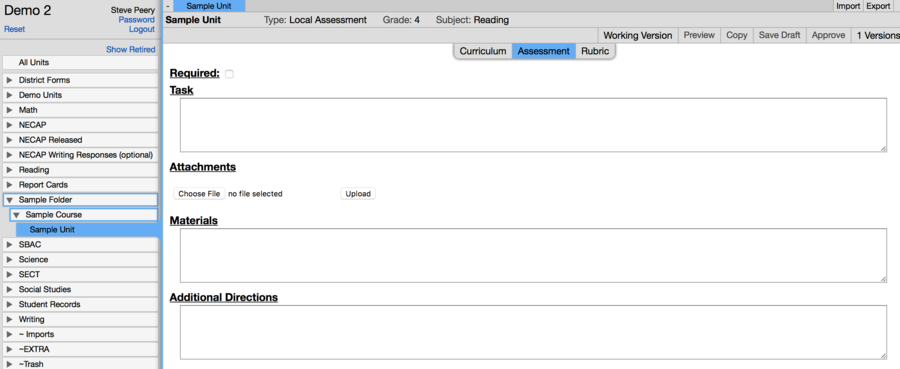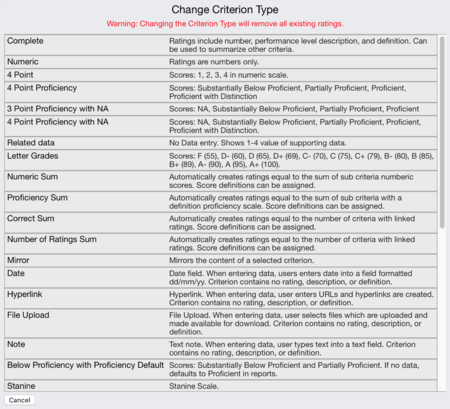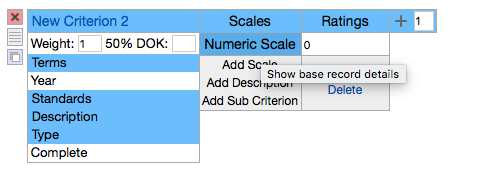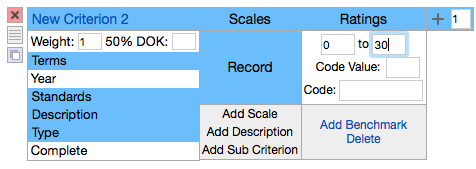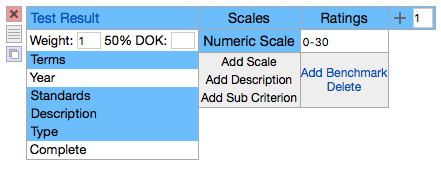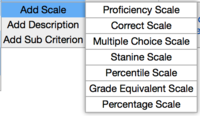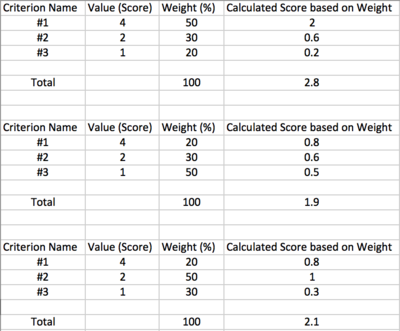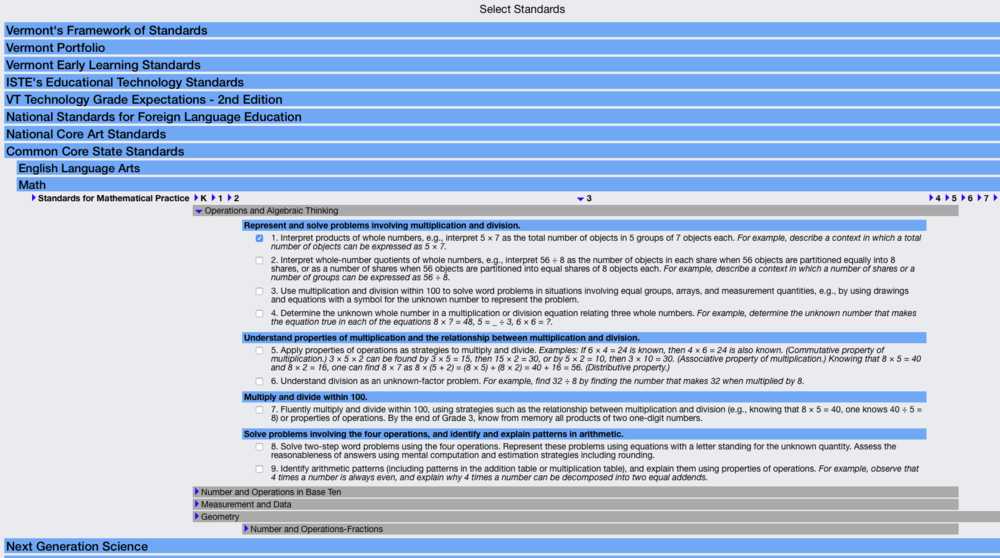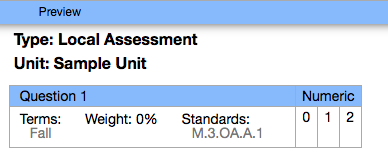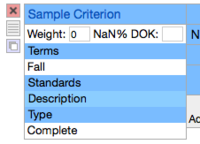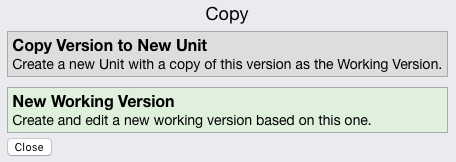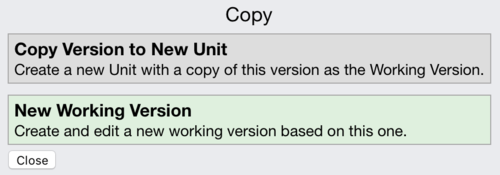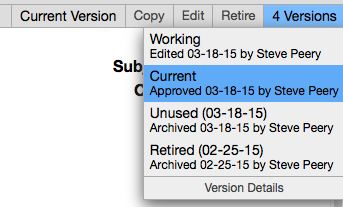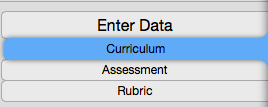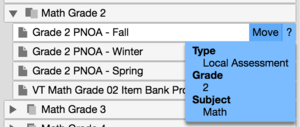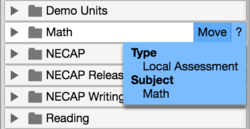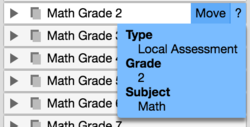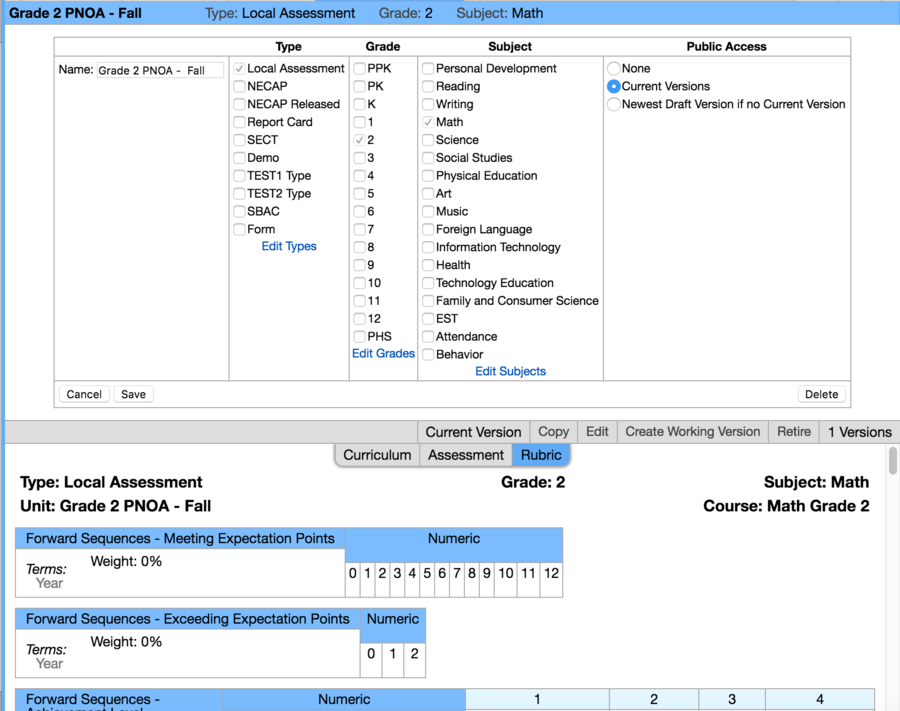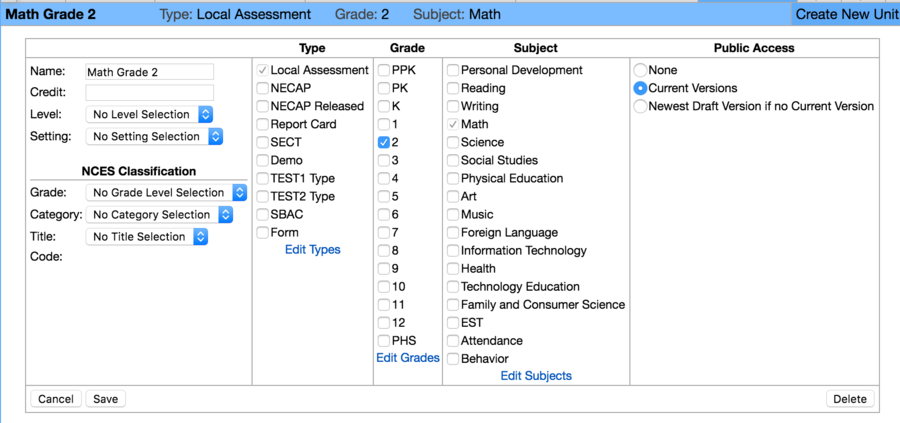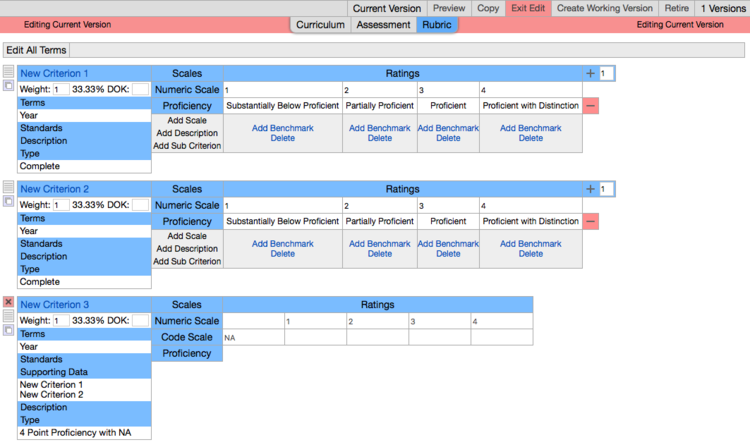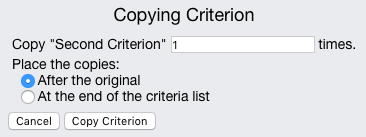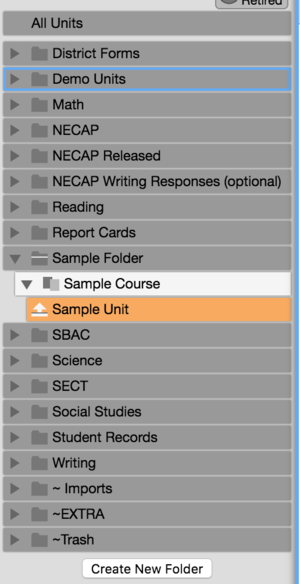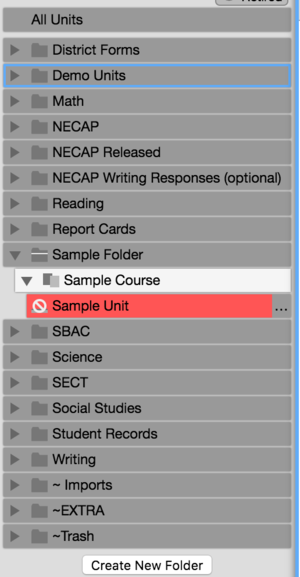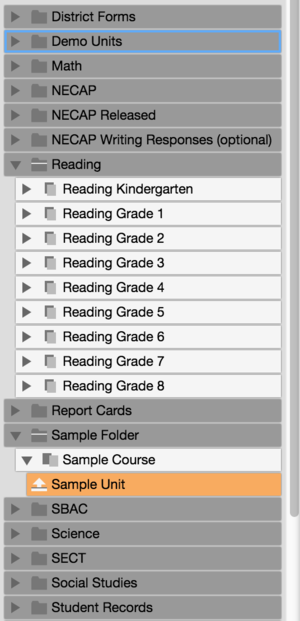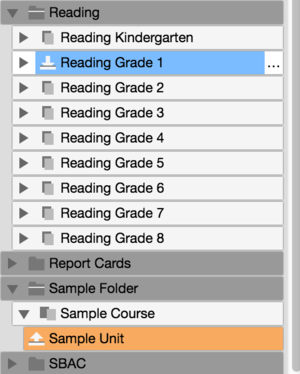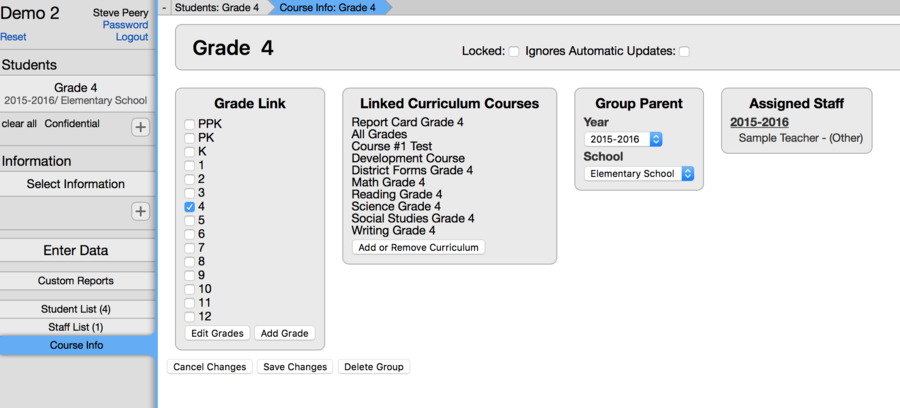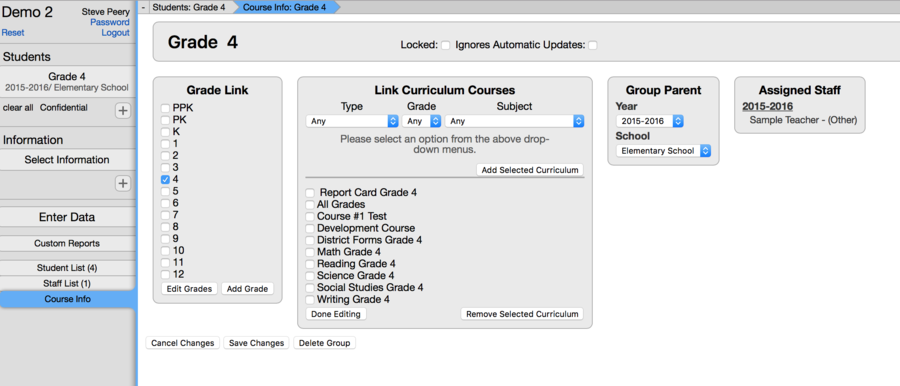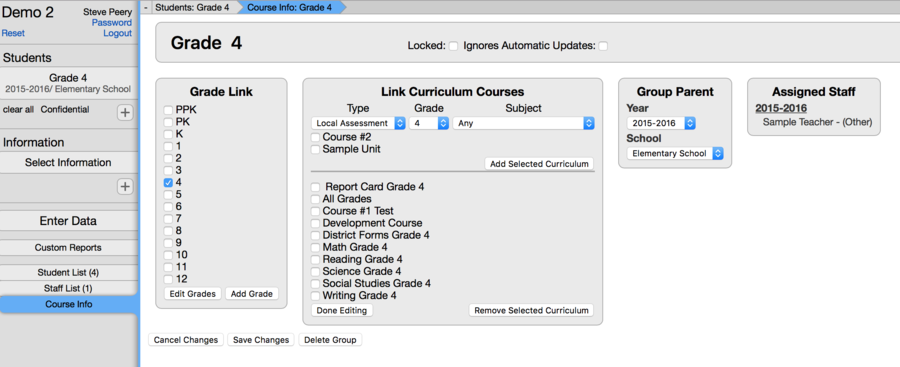Difference between revisions of "Curriculum Options"
(→To view/edit Type, Grade, Subject) |
(→View Existing Curriculum) |
||
| Line 467: | Line 467: | ||
* '''Only approved curriculum - therefore CURRENT versions - will be visible to users and available for data entry.''' | * '''Only approved curriculum - therefore CURRENT versions - will be visible to users and available for data entry.''' | ||
| + | |||
== View Existing Curriculum == | == View Existing Curriculum == | ||
| Line 489: | Line 490: | ||
* The Assessment tab will bring up a page where you can access any attachments (e.g. worksheet, scoring guide,...) that may be available, and information on task details, materials, and/or any additional directions if provided. | * The Assessment tab will bring up a page where you can access any attachments (e.g. worksheet, scoring guide,...) that may be available, and information on task details, materials, and/or any additional directions if provided. | ||
* The Rubric tab will bring you to the detail of the assessment (what is being measured and how it is measured). | * The Rubric tab will bring you to the detail of the assessment (what is being measured and how it is measured). | ||
| − | |||
| − | |||
| − | |||
== View/Edit Type, Grade, Subject == | == View/Edit Type, Grade, Subject == | ||
Revision as of 15:10, 12 December 2016
Contents
- 1 Build Curriculum
- 1.1 To add a Curriculum Folder
- 1.2 To add a Curriculum Course
- 1.3 To add a Curriculum Unit
- 1.3.1 To add a Curriculum Unit by Copying an Existing One
- 1.3.2 To add a Curriculum Unit by Creating a Brand New One
- 1.3.3 To create the Curriculum page
- 1.3.4 To create the Assessment page
- 1.3.5 To create the Rubric
- 1.3.6 To Get a New Unit Ready for Data Entry
- 1.4 Curriculum Versions
- 2 Approve Curriculum Unit
- 3 View Existing Curriculum
- 4 View/Edit Type, Grade, Subject
- 5 Edit Curriculum Unit
- 5.1 Editing the Curriculum Page
- 5.2 Editing Rubrics
- 5.3 Editing the Assessment Page
- 5.4 Editing the Curriculum Page
- 6 Move Curriculum (Folder, Course, Unit)
- 7 Link and Unlink Curriculum
Build Curriculum
All the curriculum is built under the Develop tab.
To add a Curriculum Folder
- Click on Create New Folder button at the bottom left. It will add a folder called 'New Folder'.
- Click on the 'New Folder' in the left column.
- Click on the bold words New Folder, on the top bar.
- It will drop down a section where you can edit the folder name, and assign Type, Grade, and Subjects (optional at the folder level). Type in the real name of the folder and hit Save. You will see a 'Changes successfully saved' message within a green background appear at the top, with the folder renamed.
- From here, you can 'Create New Folder' or 'Create New Course' (see top right bar).
To add a Curriculum Course
- Select the folder you want the new curriculum course to be part of.
- On the bar at the top right, click on 'Create New Course' and a 'New Course' will be created. In this example, I added this course to a folder called 'Sample Folder'. Initially, that folder was empty and didn't display any triangle in front of it. Now, it has a triangle, and it's outlined in blue to indicate that the course I'm on right now is part of this folder.
- To edit its name and assign a Type, Grade, and Subject (if not already inherited from the parent folder), click on the bold words 'New Course' on the top bar.
- From here, you can 'Create New Unit' (see top right bar).
To add a Curriculum Unit
To add a Curriculum Unit by Copying an Existing One
- Select the unit you wish to use as your starting point. If the unit you selected has multiple versions (eg Current, Woking, ...), make sure to select the version of the unit that you want to duplicate.
- Once the version you want to duplicate is selected, click on Copy, in the top menu bar, then select 'Copy Version to New Unit'. This will create a duplicate of the unit.
- By default, the unit name now bears the word 'Copy' and is the one selected.
- If the copied unit you just created needs to be moved to a different location, you can use the MOVE option.
- By default, the unit inherits the Type, Grade, and Subject from the course and/or folder in which it is located. To edit that information and/or the unit name, click on the bar at the top right of your window - where the unit name is listed in bold letters.
- When you click on that bar, it will open a drop-down window to allow you to edit the information. Any gray checks are inherited and can't be removed at this level. To edit any gray check, you will need to go to the level(s) above (e.g. course, folder) and uncheck at the level the information has been set. Blue checks indicate that they have been set at the level that you're at and can be removed. Go to the To view/edit Type, Grade, Subject section for more details.
- Make any changes needed, and hit the Save button.
- Next steps:
- Approve the unit to have it visible to users and ready for data entry.
To add a Curriculum Unit by Creating a Brand New One
- Select the course you want the new curriculum unit to be part of.
- Click on 'Create New Unit' at the top right on the bar.
- If the course and folder where the unit is going to 'live' do not already have a Type, Grade, and Subject assigned, you will get prompted and will need to assign them before you can edit this unit. Type in the real name for this unit, check the box(es) for the appropriate Type, Grade, and/or Subject, and hit the Save button.
- In this example, the new unit is called 'Sample Unit', and as you can see on the top bar, it has a Type (Local Assessment), a Grade (4), and a Subject (Reading) assigned. This new unit is a Working Version.
- Next steps:
- Approve the unit o have it visible to users and ready for data entry.
To create the Curriculum page
- From the new unit you just created (Working Version), on the Curriculum tab, you have a Description field where you can type more information about this unit.
- Click on Add a Header to choose from the options available:
- From this working version, you can click on Preview, at the top, to see what the curriculum page will look like when this new unit is approved.
- Standards for this unit will be listed on this curriculum page after they are linked to criteria in the rubric.
To create the Assessment page
- From the new unit you just created (Working Version), click on the Assessment tab.
- You can mark this unit as required by checking its Required box.
- The Task field lets you type in information about what this assessment is and how this assessment should be administered.
- The Attachments section allows you to upload important pdfs like worksheet, scoring guide, ...
- The Materials section allows you to specify what is needed for this assessment.
- Additional Directions is a field where you can add any pertinent information that may not have been covered by the other fields.
- From this working version, you can click on Preview, at the top, to see what the Assessment page will look like when this new unit is approved.
To create the Rubric
Add Criterion
- From the new unit you just created (Working Version), click on the Rubric tab.
- Click on the Add Criterion bar to add a criterion.
Criterion Type
- By default, when you add a criterion, it is of type 'Complete'. If you wish to change that type to a pre-defined type, click on the word 'Type' and it will bring you a list to choose from. The most popular ones are the 4 Point Proficiency with NA, Numeric Sum, Date, and Note criteria. IMPORTANT: Keep in mind that pre-defined criteria don't have the same flexibility as the 'Complete' type and may not allow you to add features like a description or a scale for example. To change the criterion type, click on the one you want from the list and the system will automatically change it. There is no 'undo' or 'back' button on this, so make sure that you really want to change the criterion type to a pre-defined one before clicking on the new type. Hit Cancel if you do not wish to change the type.
- The information about the criterion type only shows in Edit Mode (e.g. Working version or Edit mode on a current version).
Criterion Name
- To set the name of this criterion, click on the words 'New Criterion _' and it will open up a text field. Type in the criterion name then click Done.
Single Ratings VS Score Range
- If the criterion will have a score, you will need to add Ratings. By default, +1 is set and if you click on the +, it will add one rating, starting at a possible score of 0. You can keep clicking the + to add one rating at a time or you can change the 1 for the number of ratings you wish to add before clicking the +.
- If the possible score for this criterion does not start at 0, when clicking the + the first time, click on the 0 to change it to the value you want. When clicking the + thereafter, it will add scores following this initial value.
- To delete a rating, simply click on the blue Delete word (under Add Benchmark) for the rating you wish to delete.
- IMPORTANT: A criterion set up with single ratings will have a drop-down list of the possible scores to use where you enter data.
- If the criterion will have a greater number of possible scores (like 0-30 for example), it might be best to set it up with one rating having a range of scores from 0 to 30.
- IMPORTANT: A criterion with a score range (one rating - but a range of scores) will offer a text field box where the score will need to be typed in for data entry. It will not have a drop-down.
- To set a range of score for a criterion, click on Numeric Scale after one rating has been added.
- Set the beginning and end values of the range.
- Click on 'Record' when you are done.
- If the range of score actually needs to be broken down by proficiency levels, you will need to have the same number of ratings as you will have proficiency levels. In the following example, there will be 4 ratings - set up as 4 ranges to be able to have each one associated with a particular proficiency level.
Add Scale
- When clicking on Add Scale, you will get the list of the scales that are available. Click on the scale you wish to add.
Proficiency Scale
Score Ranges
- Click on Add Scale for the criterion you wish to edit and select Proficiency. It will add a row called Proficiency.
- To edit the proficiency, click in the row, then click under the score range you wish to assign a proficiency level. It will open the list of proficiency levels. Just click on the appropriate one to set.
- When you are done and want to get out of edit mode for the proficiency scale, just click anywhere outside of that row.
- If you ever wish to completely remove the proficiency scale row (entire row), click on the red minus sign to the right of the row.
Single Ratings
- Click on Add Scale for the criterion you wish to edit and select Proficiency. It will add a row called Proficiency.
- To edit the proficiency, click in the row.
- All the ratings are separated by little green knobs. To mark a proficiency range, hover over the green knob where you wish to divide the range. It will display ]|[. Click on it to set your divider. The divider will then show in blue.
- If you wish to remove a divider, hover over with your mouse and it will show <X and X> in red on each side of the divider.
If you click on the <X, the divider will be removed and the range will extend to the nearest divider on the left.
If you click on the X>, the divider will be removed and the range will extend to the nearest divider on the right.
- If you wish to move the divider, click on the <|> blue symbol between the red X symbols, it will set the 'movement mode' for that divider and will look like this.
- In 'movement mode', you can move a divider anywhere you wish to by simply clicking on the divider or green knob where you need it to be.
- Once you have the ranges set, click in that range within the proficiency row to set its proficiency level.
- When you are done and want to get out of edit mode for the proficiency scale, simply click anywhere outside of that row.
- If you ever wish to completely remove the proficiency scale row (entire row), click on the red minus sign to the right of the row.
Add Rating Description
- Click on Add Description; it will add a row with text boxes to type in the description for each rating (or score range).
Add Sub Criterion
- Click on Add Sub Criterion and select one criterion to add a sub criterion, or select Add All Sub Criteria for all of them.
Weight
Weight is used to summarize multiple values (scores) into one value on the Unit Reports. By default, the system gives an even weight to each criterion within a unit. You only need to change the weight if you wish to not have it evenly distributed.
To help clarify the role of the weight, here is an example of three scenarios with a different weight associated to each criterion of a unit:
- Based on the weight given to each of the criteria, the first scenario gives you a calculated score of 2.8. This score would be the score showing on this Unit Report.
- In the second scenario, the score of 1.9 would be the score appearing on the Unit Report.
- In the third and last scenario, the unit would be summarized by a score of 2.1 in the Unit Report.
- Without any specific weight associated with each criterion (by default the weight is evenly distributed between all criteria), the calculated score would be the average of all three scores (4+2+1= 7 then 7/3=2.33) therefore, it would be 2.33.
- As you can see, based on weight, the calculated score that will show on the Unit Summary Report will vary. To be clear, that calculated score is NOT a new score, it is only a way of summarizing the scores of all criteria into one single value for that unit.
- When the weight is evenly distributed between all the criteria of a unit, the summarized score for that unit is the average of all the scores.
- When a unit contains several criteria but only one is of primary importance in the Unit Report, that one criterion will be given a weight of 100% and all the others will have 0%. This is often the case, for example, for an assessment where Total Score is the one criterion chosen to give a quick snapshot of information in the Unit Report therefore, it has a weight of 100%.
To set the weight
- The system, by default, gives all criteria a value of 1 which distributes their weight evenly. If this is how it should be, then you can leave the weight as is.
- If you need to adjust the weight, in the Working Version or Edit Mode of the Current Version, click in the Weight field to change the value.
- Type in the specific value (percent) you wish each criterion to have (Example: 30 for 30%). The added weight of all criteria should total 100. If by mistake it doesn't, the system will recalculate and distribute the weight to total 100%.
- If you wish to have only one criterion with 100% of the weight, change all other criteria weight values to 0.
To Link Standards
- To link standards to a criterion, click on Standards. It will bring you to all the standards available in VCAT (National Core Art Standards, Common Core State Standards, Next Generation Science,...). Click on the ones you're interested in and select the appropriate standard(s) then hit the Save button at the bottom left. See example below:
- Once selected, the code for the standard will be displayed with the criterion where you edit the rubric, as well as in the rubric view:
- The detail of the standard(s) will show on the curriculum page:
Criterion Terms
- By default, the term for each criterion is set to 'Year'.
- To change the terms for all criteria in the unit, click on Edit All Terms above the first criterion. Check the term(s) you need, hit Apply.
- To change the terms for one criterion, click on the word Terms within that criterion settings and check the term(s) you need.
Criterion Description
- Click on the word Description between Standards and Type to add a description for the criterion.
To Get a New Unit Ready for Data Entry
- A unit needs to have a rubric with a Current Version in order to be available for data entry.
- Once you are done building/modifying the Working Version of a rubric, it has to be approved in order to become a Current Version and be available for data entry. To do that, click on Approve, in the top menu row. A separate confirmation dialog will appear. Please, take the time to read what it says and proceed by either hitting Cancel or Approve to make this working version a current version. See example below.
Curriculum Versions
- It is important to protect the evolution of an assessment (unit). Over time, the assessment might changed in what is being measured, and/or how it is being measured. The curriculum versions give you the ability to preserve this process while keeping the historical data intact.
Working version
- A working version is a new version being worked on. There is only one allowed at any given time.
- These are the options available for this kind of version:
- Preview allows you to view what this version will look like when it is approved (current).
- Copy allows you to make a copy of this version and will bring up the following dialog:
- Save Draft allows you to save this version as a draft for review and will bring up the following dialog:
- Approve will make this working version the current version, and at the same time, will retire the existing current version if there is one.
Draft version
- This is a working version upgraded to a draft version for review - multiple drafts are allowed.
- These are the options available for this kind of version:
Current version
- A current version can be one draft version OR one working version upgraded to current when it was approved - only one current version is allowed at any given time.
- Only current versions are visible to users and available for data entry.
- These are the options available for this kind of version:
- Copy allows you to make a copy of this version within a new separate unit OR a new working version for this unit you are currently in if one doesn't already exist. Here's the dialog:
- If there is already a working version in this unit, Copy will only allow you to create a new working version in a separate unit.
- Edit also allows you to create a new working version if none already exists OR allows you to edit the current version of this unit. If the Current version has data, you will get a warning message with a red background. See the difference in the dialogs below:
- Create Working Version will ONLY be an option if the current version doesn't already have a working version.
- Retire allows you to retire a current version so it will no longer be available for data entry.
Retired version
- A retired version is an old current version that got automatically retired either when a new working version was approved and became current OR directly retired without any other current version available.
- These are the options available for this kind of version:
- Copy allows you to create a new working version within this unit if none already exists OR a new working version in a separate unit.
- Edit again allows you to create a new working version within this unit if none already exists OR allows you to edit this retired version. If data has been entered in this version, a warning with a red background will be displayed.
Unused version
- An unused version is one of the draft versions upgraded to unused at the time when one of them was approved and became current.
- These are the options available for this kind of version:
Version Selection
- A unit can have multiple versions. When it does and you wish to view a different version, click on Versions on the top right (the # preceding indicates how many versions this unit has) and select the version you would like to view.
Version Details
- If you click on Version Details, it will provide you with information about each version, and it will also indicate if each one can be deleted or not. This is a convenient feature to delete unwanted working version for example.
Approve Curriculum Unit
- Select the unit you wish to approve - it can either be a Working Version or a Draft Version.
- Click on Approve.
- A Confirm Approve dialog will appear with the options to Cancel or Approve.
- When approved, a Working Version will become Current, and if there was already an existing Current, it will be automatically Retired, and a Draft Version (if any) will be marked as Unused.
- When approved, a Draft Version will become Current, and if there was already an existing Current, it will be automatically Retired. A Working Version (if any) will remain a Working Version.
- Only approved curriculum - therefore CURRENT versions - will be visible to users and available for data entry.
View Existing Curriculum
Under the Data tab:
- Click on Select Information. Use the filters at the top to narrow down the list presented to you. Click on the curriculum course to see the curriculum units it contains.
- Click on the curriculum unit you are interested in.
- If the unit you selected is available to you for data entry, you will be prompted by a calendar, hit cancel.
- Click on Curriculum to see the curriculum page.
- Click on Rubric to see the detail of the assessment (what is being measured and how it is measured).
- Click on Assessment to access any attachments (e.g. worksheet, scoring guide,...) that may be available, task details, materials, and any additional directions.
If you have FULL Access or Curriculum Development Access, you can also view the curriculum under the Develop Tab.
Under the Develop tab:
- You can click on All Units and use the filter to locate the course/unit you're interested in in the list. Then hover over the unit name and click on it to go right to it OR you can navigate in the left column by clicking on the triangle to open the folder and course you're interested in, and clicking on the unit you wish to go to.
- When you have selected a unit, you will see three tabs: Curriculum, Assessment, and Rubric.
- The Curriculum tab will bring up the curriculum page.
- The Assessment tab will bring up a page where you can access any attachments (e.g. worksheet, scoring guide,...) that may be available, and information on task details, materials, and/or any additional directions if provided.
- The Rubric tab will bring you to the detail of the assessment (what is being measured and how it is measured).
View/Edit Type, Grade, Subject
- The Types, Grades, and Subjects linked to a unit are directly connected to the Types, Grades, and Subjects in the Access Sets.
- A least one Type, one Grade, and one Subject are needed for every unit, but it can also have multiple ones. Those three elements may or may not be inherited from the course and/or folder in which the unit is located.
- You can quickly see the details of the Type, Grade, and Subject by hovering over to the right of the unit you are interested in under the Develop tab:
- You can do the same for the folder and the course:
- When you wish to adjust/edit any of these three elements (Type, Grade, Subject) for a unit, select the unit, click on the top bar where the unit name is written in bold letters - It is highlighted in blue right now because I hovered over it before clicking on it:
- A drop-down with the details will display after you click on the top bar:
- When the checks are GRAY, they are inherited either from the course it belongs to, or the folder it's in. You need to select the level where those elements have been set in order to be able to edit them, if needed. You can add more checks (type, grade, and/or subject) but can't changed the existing ones in this case unless you select the course and/or folder.
- A blue check indicates that the element was set at the level selected, and therefore, can be edited:
- After making any changes to the Type, Grade, Subject, click on the Save button to save the changes.
- The blue 'Edit Types', 'Edit Grades', and 'Edit Subjects' allow you to edit the name of the existing ones listed, as well as the ability to delete or add new ones to the list.
Edit Curriculum Unit
In order to edit the curriculum, you have to be on the Develop tab.
Editing the Curriculum Page
- Select the unit.
- When on the Curriculum tab, click on the Edit button if the curriculum page you wish to edit is in the current version.
- If the version is a Working Version, you are already in Edit mode and can make the changes needed right away.
Editing Rubrics
Add Criterion
- Click on How to Add a Criterion to learn more.
Delete Criterion
- In a Working Version, under the Rubric tab, click on the red X to the left of the criterion you wish to delete.
- In a Current Version, no criterion with data should ever be deleted. The red X to the left of the criterion should only be available for the criteria without any data. Clicking on that red X will delete the criterion.
Ordering Criterion
- To reorder a criterion, place your mouse over the dragging handle symbol
 to the left of the criterion - you will see an up and down arrow appear - click and hold down to drag the criterion, and release when you're done. If you have to move the criterion beyond the criterion list visible on your screen, you will need to repeat these steps.
to the left of the criterion - you will see an up and down arrow appear - click and hold down to drag the criterion, and release when you're done. If you have to move the criterion beyond the criterion list visible on your screen, you will need to repeat these steps.
Copy a Criterion
- To copy a criterion, click on the Copy symbol
 on the left side of the criterion. A Copying Criterion dialog will come up to allow you to set how many times you want this criterion to be copied, and where the copies should be placed. Click on the Copy Criterion button. The criterion will be copied and the word 'Copy' will be added to its name.
on the left side of the criterion. A Copying Criterion dialog will come up to allow you to set how many times you want this criterion to be copied, and where the copies should be placed. Click on the Copy Criterion button. The criterion will be copied and the word 'Copy' will be added to its name.
Add Ratings
- By default, +1 is set for the criterion and if you click on the +, it will add one rating with the next numeric value. If it's a new criterion, the rating will start at a possible score of 0. You can keep clicking the + to add one rating at a time or you can change the 1 for the number of ratings you wish to add before clicking the +.
- If the possible score for this criterion does not start at 0, when clicking the + the first time, click on the 0 to change it to the value you want. When clicking the + thereafter, it will add scores following this initial value.
Delete Ratings
- To delete a rating, simply click on the blue word 'Delete' (under Add Benchmark) for the rating you wish to delete.
Standards
- Click on Standards to learn more on how to link standards to criteria.
Weight
- Click on Weight to learn more.
Depth of Knowledge
- Type in the information in the box to the right of DOK.
Terms
- To change the terms for all criteria in the unit, click on Edit All Terms above the first criterion. Check the term(s) you need, hit Ae apply.
- To change the terms for one criterion, click on the word Terms within that criterion settings and check the term(s) you need. If the term you need is not listed, it will have to be created before it can be selected. To learn how to create a new term, click NEW TERM.
Description
Criterion Description
- This description is used to provide more information about the criterion. To add or edit the criterion description, click on the word Description with the blue background, right below the Standards.
Rating Description
- This description is used to provide more information about the ratings of the criterion. To add or edit the rating description, click on the Add Description, below Numeric Scale.
- The following is an example of how the rating description is used:
Sub Criteria
- To link sub criteria, click on Add Sub Criterion, under the Numeric Scale.
- Select Add All Sub Criteria, or pick an individual criterion. If you select individual ones, you need to click on Add Sub Criterion prior to making each single selection.
- If the type of criterion you are adding sub criteria to is 'Numeric Sum', the system will automatically add the correct number of ratings based on the sub criteria linked.
Supporting Data
- At this time, only the criterion type '4 pt proficiency with NA' offers the Supporting Data feature. Click on Supporting Data (below Standards), check the appropriate supporting data, hit Save. In order for the supporting data to come through to the criterion, that supporting data needs to have a proficiency scale. It is the proficiency level that is used as supporting data.
Benchmark
- Click on Add Benchmark (in blue) under the rating you wish to link a benchmark to.
- Choose the file to be used as benchmark, click Upload, and hit Save.
Threshold
Thresholds can only be set when sub criteria have been linked to a criterion.
- If the total score of the sub criteria is what is important (and not the score for each particular criterion), type in the values in the Sum of Scores row. See example below.
- If the score of a particular sub criterion is what is important, click on the blue + under the Numeric Scale rating, and type in the score in the left cell.
- Below is another sample of how thresholds can be used. Thresholds can get very confusing and complicated. Please, do not hesitate to contact VCAT Support for guidance.
Editing the Assessment Page
- Select the unit for which you want to edit the assessment page.
- Click on the Assessment tab.
- If you want to Edit the Assessment Page of a Current Version, click on Edit, in the top row options, and select Current Version.
- If the version is already a Working Version, you can edit right away.
- Click on Assessment Page to learn more.
Editing the Curriculum Page
- Select the unit for which you want to edit the curriculum page.
- Click on the Curriculum tab.
- If you want to Edit the Curriculum Page of a Current Version, click on Edit, in the top row options, and select Current Version.
- If the version is already a Working Version, you can edit right away.
- Click on Curriculum Page to learn more.
Move Curriculum (Folder, Course, Unit)
- Hover over to the right of the folder/course/unit you wish to move to a different location. You should see the Move option.
- Click on the Move option. Depending if you're moving a unit, a course, or a folder, you will see acceptable locations displayed with a white background. Moving your cursor away from the unit you wish to move and the unit will be highlighted in orange, indicating that the move option has been initiated for it.
- If you no longer wish to move the selected unit (or folder/course), clicking on it when it is highlighted in red will cancel the initiated move.
- If you're trying to move a unit, for example, and the course you wish to move that unit into is not showing, click on the arrow in front of the folder where the course is located to allow you to see the course (destination of the unit).
- Move your cursor to the destination (folder/course), and click on it when it is highlighted in blue and it will move into it.
Link and Unlink Curriculum
In order to have curriculum/assessments available to teachers for data entry, that curriculum needs to be linked to the student groups at the course level.
Link Curriculum
Here are the steps to link curriculum courses (and their units):
- Select the year, the school, and the course (e.g. Grade 3, Math 4, Literacy 5,...).
- Click on Course Info in the left column.
- In the Linked Curriculum Courses section, click Add or Remove Curriculum.
Note: Any curriculum already linked will show below the line under Add Selected Curriculum.
- Select Type, Grade, and/or Subject to populate the list of curriculum/assessments available.
- Check the curriculum you wish to link.
- Click on Add Selected Curriculum. It will move the curriculum you just selected below the line under Add Selected Curriculum.
- If you need to link a different curriculum that didn't show up in the list of curriculum available, change your filter for Type, Grade, and/or Subject to re-populate a new list. Again, check the curriculum you wish to add, and click on Add Selected Curriculum.
- If you are done adding curriculum, click on Done Editing button at the bottom left of the Link Curriculum Courses section.
- Then click on Save Changes below.
Unlink Curriculum
Here are the steps to unlink curriculum courses (and their units):
- Select the year, the school, and the course (e.g. Grade 3, Math 4, Literacy 5,...).
- Click on Course Info in the left column.
- In the Linked Curriculum Courses section, click Add or Remove Curriculum.
Note: The curriculum already linked is listed below the line under Add Selected Curriculum.
- Check the curriculum you wish to unlink.
- Click on Remove Selected Curriculum.
- Click on Done Editing button at the bottom left of the Link Curriculum Courses section.
- Then click on Save Changes below.
